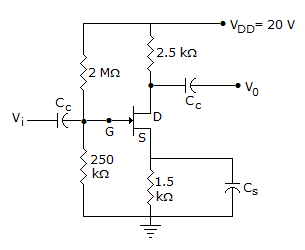Question

a.
20 V
b.
10 V
c.
30 V
d.
1 V
Posted under Electronics and Communication Engineering
Interact with the Community - Share Your Thoughts
Uncertain About the Answer? Seek Clarification Here.
Understand the Explanation? Include it Here.
Q. In figure, ID = 4 mA. Then VD =
Similar Questions
Explore Relevant Multiple Choice Questions (MCQs)
Q. A circuit using an op-amp is shown in the given figure. It has
View solution
Q. In figure VBE = 0.7 V. The base current is
View solution
Q. The circuit in the given figure is
View solution
Q. A bridge diode circuit using ideal diodes has in input voltage of 20 sin ωt volts. The average and rms values of output voltage are
View solution
Q. In the circuit of figure v1 = 8 V and v2 = 0. Which diode will conduct (Assume ideal diodes)?
View solution
Q. In the circuit of figure β = 100 and quiescent value of base current is 20 μA. The quiescent value of collector
View solution
Q. In figure which diode will conduct and what will be the value of V0?
View solution
Q. For the amplifier circuit of figure, the h parameters of transistor are hib = 25 Ω, hfb = 0.999, hob = 10¯⁶ Ω. The voltage gain is
View solution
Q. In figure, VCC = + 30 V, R1 = 200 kΩ and R2 = 100 kΩ. If VBE = 0.7 V, the voltage a cross RE =
View solution
Q. The Vo of the op-amp circuit shown in the given is
View solution
Q. In figure base current is 10 μA and βdc = 100. Then VE =
View solution
Q. In the figure, assume the op-amp is to be ideal. The output Vo if the circuit is
View solution
Q. Assuming VCE sat = 0.2 V and β = 50, the minimum base current (IB) required to drive the transistor in the given figure to saturation is
View solution
Q. In the op-amp circuit given in the figure, the load current iL is
View solution
Q. In figure, secondary winding has 40 turns. For maximum power transformer to 2 ohm resistance the number of turns in primary is
View solution
Q. In figure if the transistor is cut off, the collector voltage is equal to
View solution
Q. In figure, D1 turns on when
View solution
Q. In the circuit of figure both diodes are ideal. If v1 = 10 V and v2 = 10 V which diode will conduct?
View solution
Q. In the circuit of the given figure, assume that the diodes are ideal and the meter is an average indicating ammeter, the ammeter will read
View solution
Q. In the following figure C = 0.02 μF, and Vth is known to be of frequency ω = 10⁷ rad/sec and rd = 2.5 Ω and ZTh = RTh = 10 Ω Then phase angle between id and Vd
View solution
Recommended Subjects
Are you eager to expand your knowledge beyond Electronics and Communication Engineering? We've handpicked a range of related categories that you might find intriguing.
Click on the categories below to discover a wealth of MCQs and enrich your understanding of various subjects. Happy exploring!








